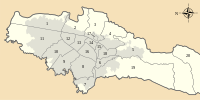Bogotá savanna
| Bogotá savanna | |
| Plateau | |
 The Bogotá savanna near the city of Bogotá | |
| Country | |
|---|---|
| State | Cundinamarca |
| Part of | Altiplano Cundiboyacense |
| Cities | Bogotá, Soacha, Chía, Facatativá, Zipaquirá |
| River | Bogotá |
| Coordinates | 4°45′0″N 74°10′30″W / 4.75000°N 74.17500°WCoordinates: 4°45′0″N 74°10′30″W / 4.75000°N 74.17500°W |
| Capital | Bogotá |
| - elevation | 2,640 m (8,661 ft) |
| Area | 4,500 km2 (1,737 sq mi) |
| Population | 9,348,588 (2015-16) |
| Density | 2,077/km2 (5,379/sq mi) |
| Geology | Cenozoic-Holocene |
| Orogeny | Eastern Ranges, Andes |
| Timezone | Colombia Standard Time (UTC-5) |
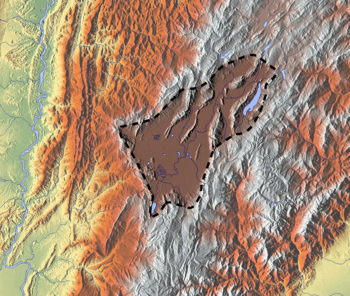 Topography and outline of the Bogotá savanna
| |
The Bogotá savanna is a high plateau located in the center of Colombia in the Eastern Ranges of the Colombian Andes. It is the southern part of a larger plateau called Altiplano Cundiboyacense that rises to an average altitude of 2,600 metres (8,500 ft) above sea level.
This plateau is crossed from north to south by the Bogotá River, which at the southwestern edge of the plateau forms the Tequendama Falls (Salto del Tequendama). Other rivers, tributaries of the Bogotá river, form smaller valleys with very fertile soils dedicated to agriculture and cattle-breeding.
Etymology
The Bogotá savanna is named after Bogotá, which is derived from Muysccubun Bacatá, which means "(Enclosure) outside of the farm fields".[1]
Climate
The average temperature of the plateau is 14 °C, but this can fluctuate between 0 °C and 24 °C. The dry and rainy seasons alternate frequently during the year. The dry months are December, January, February and March. During the rainy months the temperature tends to be more stable with variations between 9 °C and 20 °C. June, July and August are the months that present the largest variations of temperature, and during the morning frost is regular, which has a negative impact on agriculture. Hail or ice storms are also common.[2][3]
Hydrology
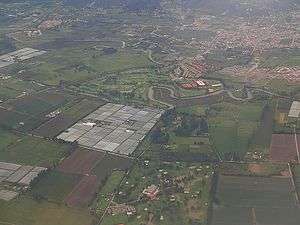

There is a system of swamps (humedales) that regulate the soil moisture acting like sponges for the rain waters. The most important wetlands are: La Conejera, El Burro, Jaboque, Santa María del Lago, Tibabuyes, Córdoba and Guaymaral.[4]
Rivers
- Bogotá River - 375 kilometres (14,800,000 in)
- Bojacá River
- Fucha River
- Funza River
- Tunjuelito River
Lakes
Natural
- Lake Guatavita - overlooking the northeastern part of the savanna
- Lake Herrera
Artificial
- Tominé Reservoir - northeast, biggest waterbody on the Bogotá savanna - 690 cubic megametres (2.4×1022 cu ft)
- Neusa Reservoir - north - 102 cubic megametres (3.6×1021 cu ft)
- El Muña Reservoir - south - 42 cubic megametres (1.5×1021 cu ft)
- Lake Herrera (since 1973)[5]
Waterfalls
- Tequendama Falls - southwestern limit
History
The earliest confirmed inhabitation of present-day Colombia was on the Bogotá savanna with sites El Abra, Tequendama and Tibitó, where semi-nomadic hunter-gatherers lived in caves and rock shelters. One of the first evidences of settlement in open area space was Aguazuque, whose oldest dated remains are analysed to be 5000 years old. This prehistorical preceramic period was followed by the Herrera Period, commonly defined from 800 BCE to 800 AD.
At the arrival of the Spanish conquistadors the region was inhabited by the Muisca who lived in hundreds of villages scattered across the plateau. These villages were individually ruled by caciques who at the same time paid tribute to the zipa, ruler of Bacatá. After the defeat of the Muisca rulers, Bogotá was founded and the Spanish colonizers engaged in the construction of Spanish-style towns to replace all the indigenous villages and in the process of assimilation and religious convert of the Muisca. The majority of those villages kept their indigenous names, but some were slightly modified in time, like Suacha which became Soacha, Hyntiba becoming Fontibón and Bacatá becoming Bogotá.
Timeline of inhabitation
| Timeline of inhabitation of the Bogotá savanna, Colombia | |
 |
.png)   |
Cities
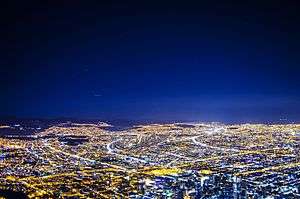

.svg.png)
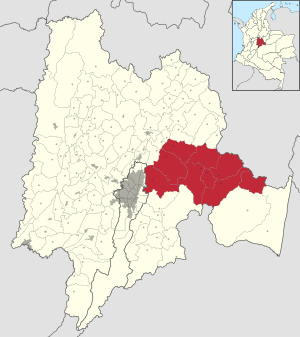
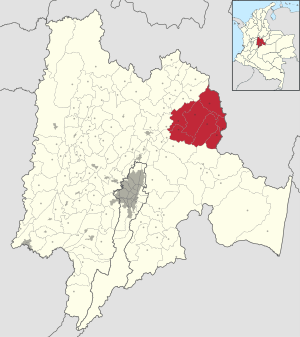


Litho by Ramón Torres Méndez

The main cities of the Bogotá savanna, in addition to the capital city of Bogotá, are: Mosquera, Soacha, Madrid, Funza, Facatativá, Subachoque, El Rosal, Tabio, Tenjo, Cota, Chía, Cajicá, Zipaquirá, Nemocón, Sopó, Tocancipá, Gachancipá, Sesquilé, Suesca, Chocontá and Guatavita.[6]
List of municipalities
| Municipality Locality |
Altitude urban centre (m) |
Surface area (km2) |
Inhabitants[note 1] | Remarks | Map |
|---|---|---|---|---|---|
| Bogotá | 1587 | 7,980,00116 | Named after Bacatá[note 2] Capital of Colombia Biggest city at altitudes above 2,500 metres (8,200 ft) |
 | |
| Usaquén | 2650 | 65.31 | 449,62116 |  | |
| Chapinero | 2640 | 38.15 | 122,50707 |  | |
| Santa Fe | 2640 | 45.17 | 96,24107 | 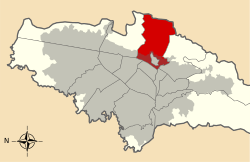 | |
| San Cristóbal | 2640 | 49.09 | 404,35007 |  | |
| Usme | 2700 | 119.04 | 314,43107 | 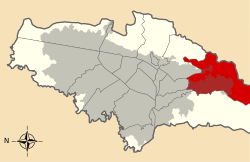 | |
| Tunjuelito | 2600 | 9.91 | 182,53207 |  | |
| Bosa | 2600 | 23.93 | 637,28315 | 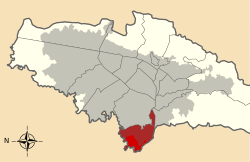 | |
| Kennedy | 2700 | 38.59 | 979,91407 | 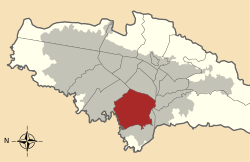 | |
| Fontibón | 2600 | 33.28 | 317,17907 | 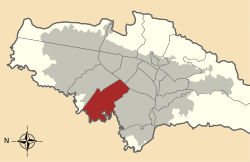 | |
| Engativá | 2600 | 35.88 | 824,33707 |  | |
| Suba | 2700 | 100.56 | 1,161,50016 | 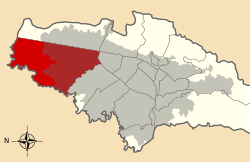 | |
| Barrios Unidos | 2600 | 11.9 | 230,06607 |  | |
| Teusaquillo | 2600 | 14.19 | 139,29807 | 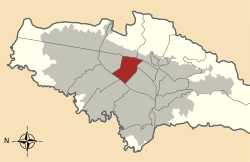 | |
| Los Mártires | 2600 | 6.51 | 94,94407 | 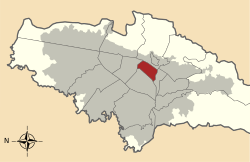 | |
| Antonio Nariño | 2600 | 4.88 | 119,56507 | 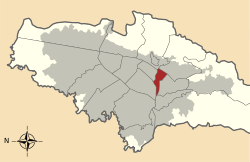 | |
| Puente Aranda | 2600 | 17.31 | 250,71507 | 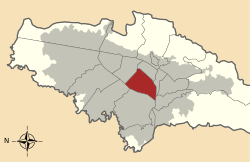 | |
| La Candelaria | 2640 | 2.06 | 22,11507 |  | |
| Rafael Uribe Uribe | 2600 | 13.83 | 378.78007 | 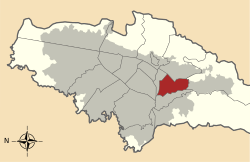 | |
| Ciudad Bolívar | 2700 | 130 | 593,93707 |  | |
| Soacha | 2565 | 184.45 | 522,44216 | Preceramic site Tequendama Herrera site Muisca ceramics production Petrographs found |
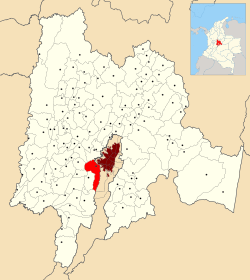 |
| Sibaté | 2700 | 125.6 | 38,41215 | Petrographs found El Muña Reservoir |
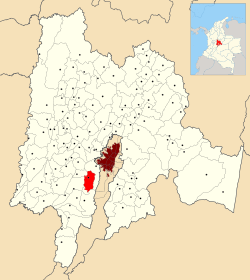 |
| Mosquera | 2516 | 107 | 82,75015 | Lake Herrera Petrographs found |
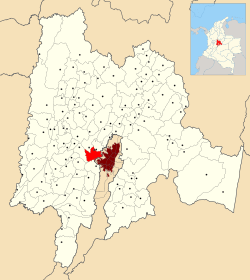 |
| Bojacá | 2598 | 109 | 11,25415 | Lake Herrera Petrographs found |
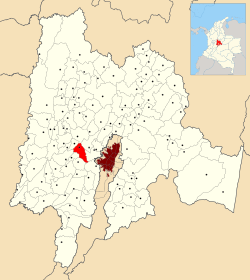 |
| Chía | 2564 | 80 | 129,65216 | Moon Temple Herrera site Petrographs found |
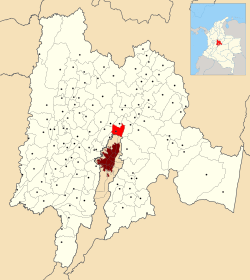 |
| Cota | 2566 | 55 | 24,91615 | Petrographs found Muisca community |
 |
| Cajicá | 2558 | 50.4 | 56,87515 | Located in the funnel of the northern savanna | 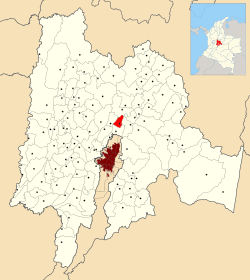 |
| Facatativá | 2586 | 158 | 134,52215 | Piedras del Tunjo |  |
| Funza | 2548 | 70 | 75,35015 | Muisca market town | 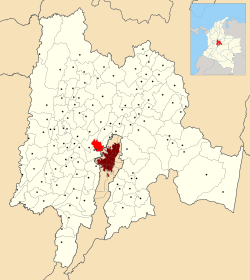 |
| Madrid | 2554 | 120.5 | 77,62715 | Lake Herrera Petrographs found |
 |
| El Rosal | 2685 | 86.48 | 17,25415 | 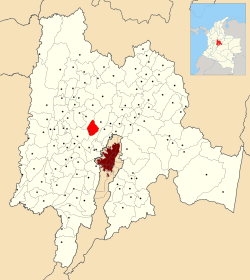 | |
| Zipacón | 2550 | 70 | 557015 | Agriculture Place of meditation for the zipa Petrographs found |
 |
| Subachoque | 2663 | 211.53 | 16,11715 | Petrographs found | 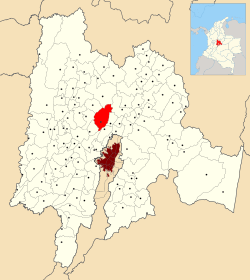 |
| Tabio | 2569 | 74.5 | 27,03315 | Hot springs used by the Muisca |  |
| Tenjo | 2587 | 108 | 18,38715 | Petrographs found |  |
| Zipaquirá | 2650 | 197 | 124,37615 | El Abra Muisca salt mines Important market town Petrographs and petroglyphs found |
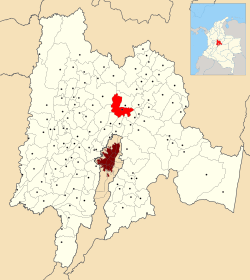 |
| Nemocón | 2585 | 98.1 | 13,48815 | Muisca salt mines Preceramic site Checua Petrographs found |
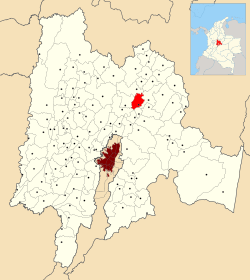 |
| Cogua | 2600 | 113 | 22,36115 | Muisca ceramics production Petrographs found Neusa Reservoir |
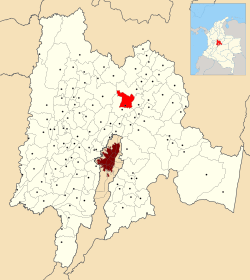 |
| Tocancipá | 2605 | 73.51 | 31,97515 | Preceramic site Tibitó Muisca ceramics production Important market town Petrographs found |
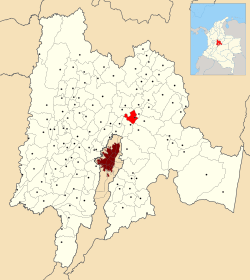 |
| Gachancipá | 2568 | 44 | 14,44215 | Muisca mummy found Muisca ceramics production |
 |
| Guasca | 2710 | 346 | 14,75915 | Siecha Lakes Muisca ceramics production Petrographs found |
 |
| Guatavita | 2680 | 247.3 | 689815 | Muisca ceramics production Main goldworking town Petrographs found Tominé Reservoir |
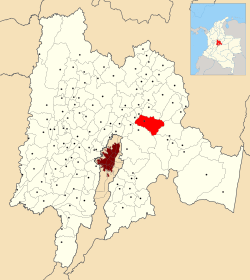 |
| Sopó | 2650 | 111.5 | 26,76915 | Herrera site | 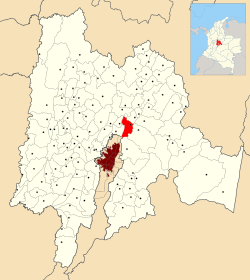 |
| Sesquilé | 2595 | 141 | 13,93615 | Lake Guatavita Minor Muisca salt mines |
 |
| Suesca | 2584 | 177 | 17,31815 | 150 Muisca mummies found Lake Suesca Muisca ceramics production Important market town Petrographs found |
 |
Panoramas







See also
Notes
References
- ↑ (Spanish) Etymology Bacatá - Banco de la República
- ↑ "Climate: Bogotá - Climate graph, Temperature graph, Climate table". Climate-Data.org. Retrieved 2016-09-29.
- ↑ "Weatherbase: Historical Weather for Bogota, Colombia". Weatherbase. Retrieved 2016-09-29.
- ↑ (Spanish) Descripción General de los Humedales de Bogotá
- ↑ (Spanish) Lake Herrera largest water reserve of the Bogotá savanna
- ↑ Cities on the Bogotá savanna Archived November 13, 2013, at the Wayback Machine.
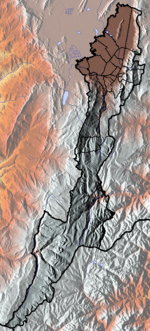
.svg.png)


